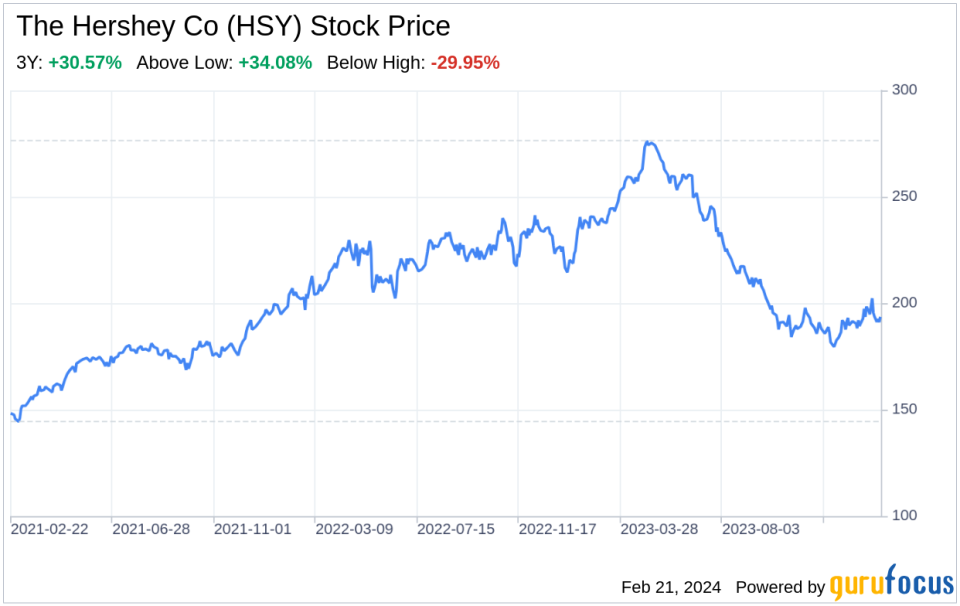Decoding The Hershey Co (HSY): A Strategic SWOT Insight
Comprehensive SWOT analysis of The Hershey Co reveals a robust brand portfolio and strategic acquisitions as key strengths.
Opportunities for The Hershey Co include expanding its international presence and leveraging new snacking trends.
Threats such as supply chain disruptions and competitive pressures could impact The Hershey Co's market dominance.
Weaknesses like reliance on the North American market and potential raw material price volatility require strategic attention.
On February 20, 2024, The Hershey Co (NYSE:HSY), a titan in the confectionery industry, filed its 10-K report, offering a window into its financial health and strategic positioning. As a leading manufacturer with a commanding 45% share of the U.S. chocolate market, Hershey's portfolio boasts over 100 brands, including Reese's and Kit Kat. Despite a strong domestic presence, international sales account for a modest segment of its revenue. The 10-K filing provides a financial overview, revealing Hershey's strategic acquisitions like SkinnyPop and Dot's Pretzels, which diversify its offerings beyond confectionery. The company's financial tables indicate a solid balance sheet and sustained revenue growth, underscoring its financial resilience in a competitive market.

Strengths
Brand Portfolio and Market Leadership: The Hershey Co's strength lies in its impressive brand portfolio, which includes household names like Hershey's, Reese's, and Kit Kat. These brands not only enjoy widespread consumer recognition but also command significant shelf space in retailers across North America. The company's market leadership is further cemented by its 45% share of the U.S. chocolate market, a testament to its strong brand equity and loyal customer base. This dominance provides a competitive edge and pricing power, which is critical in a market where brand loyalty is paramount.
Strategic Acquisitions and Diversification: Hershey's strategic acquisitions, such as SkinnyPop, Dot's Pretzels, and Lily's Sweets, demonstrate its commitment to diversification and innovation. These acquisitions have allowed Hershey to tap into the growing demand for healthier snack options and cater to evolving consumer tastes. By expanding its product range, Hershey has not only mitigated the risks associated with reliance on traditional confectionery but also positioned itself to capture new snacking occasions, driving revenue growth and market expansion.
Weaknesses
Dependence on North American Markets: Despite its international presence, The Hershey Co's sales outside North America contribute only a single-digit percentage to its total revenue. This heavy reliance on the North American market exposes the company to regional economic fluctuations and limits its growth potential. Diversifying its geographic revenue streams could reduce this vulnerability and provide a more balanced portfolio of risk and opportunity.
Raw Material Price Volatility: The Hershey Co's dependence on raw materials like cocoa, sugar, and dairy products, which are subject to price volatility, presents a weakness. Fluctuations in these commodity prices can significantly impact production costs and profit margins. While Hershey employs hedging strategies to mitigate these risks, the potential for sudden price changes remains a challenge that could affect financial performance.
Opportunities
International Market Expansion: The Hershey Co has the opportunity to expand its international footprint, particularly in emerging markets where demand for confectionery and snacks is growing. By leveraging its strong brand recognition and adapting its product offerings to local tastes, Hershey can tap into new consumer segments and drive global sales. This expansion would also help balance the company's reliance on the North American market and provide new avenues for revenue growth.
Snacking Trends and Innovation: The rise of health-conscious consumers and the demand for convenient, on-the-go snack options present significant opportunities for Hershey. The company's recent acquisitions align with these trends, and continued innovation in product development could further capitalize on the shift in consumer preferences. By staying ahead of the curve with new flavors, formats, and health-oriented products, Hershey can strengthen its market position and attract a broader customer base.
Threats
Supply Chain Disruptions: The Hershey Co's supply chain is susceptible to disruptions caused by natural disasters, political unrest, and other unforeseen events, particularly in cocoa-producing regions. Such disruptions could lead to shortages and increased costs for raw materials, adversely affecting production and profitability. Proactive supply chain management and diversification of sourcing are crucial to mitigate these risks.
Competitive Pressures: The confectionery and snack markets are highly competitive, with numerous multinational and local players vying for market share. Intense competition requires continuous investment in marketing, product innovation, and price competitiveness. Hershey must navigate these pressures to maintain its leadership position and avoid losing ground to competitors who may offer similar products at lower prices or with innovative features.
In conclusion, The Hershey Co (NYSE:HSY) exhibits a robust SWOT profile, with its strong brand portfolio and strategic acquisitions serving as key strengths. However, the company must address weaknesses such as its dependence on the North American market and the volatility of raw material prices. Opportunities for international expansion and capitalizing on snacking trends are within reach, while threats from supply chain disruptions and competitive pressures loom. By leveraging its strengths and opportunities while strategically addressing its weaknesses and threats, Hershey is well-positioned to continue its confectionery and snacking dominance.
This article, generated by GuruFocus, is designed to provide general insights and is not tailored financial advice. Our commentary is rooted in historical data and analyst projections, utilizing an impartial methodology, and is not intended to serve as specific investment guidance. It does not formulate a recommendation to purchase or divest any stock and does not consider individual investment objectives or financial circumstances. Our objective is to deliver long-term, fundamental data-driven analysis. Be aware that our analysis might not incorporate the most recent, price-sensitive company announcements or qualitative information. GuruFocus holds no position in the stocks mentioned herein.
This article first appeared on GuruFocus.
